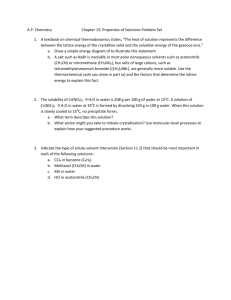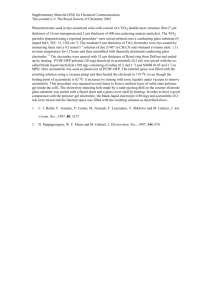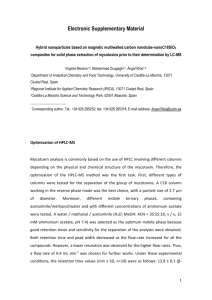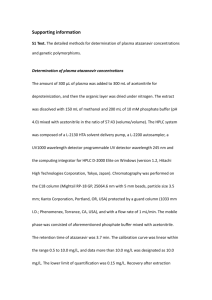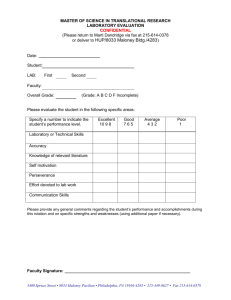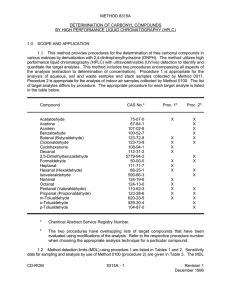METHOD 8033 ACETONITRILE BY GAS CHROMATOGRAPHY WITH NITROGEN-PHOSPHORUS DETECTION 1.0
advertisement
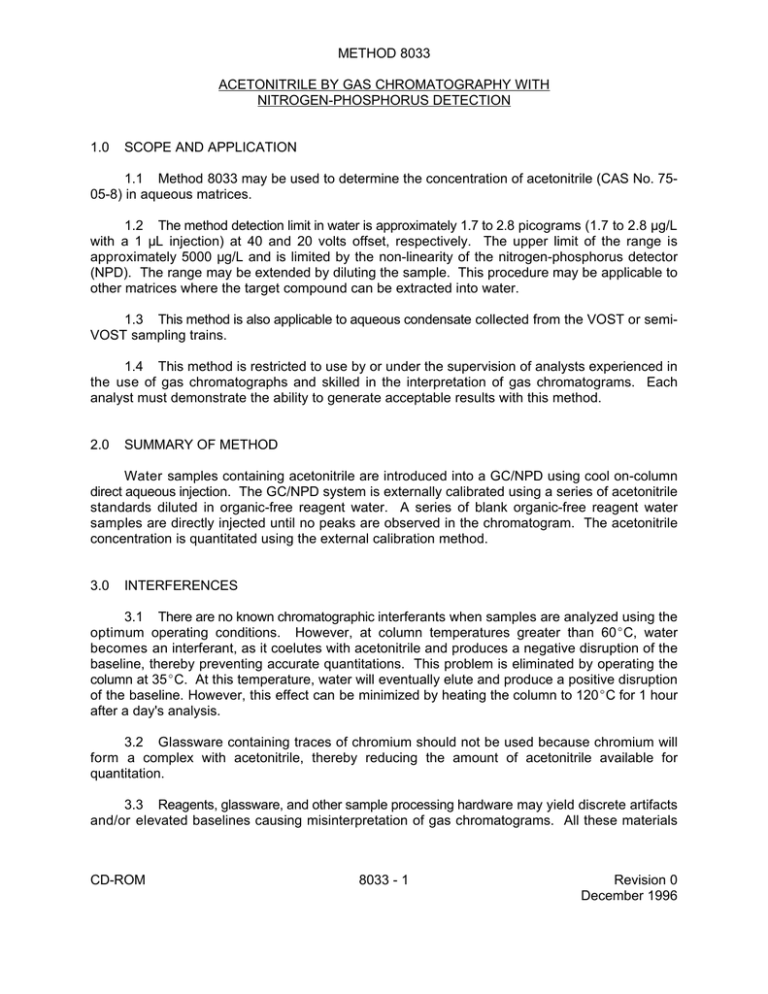
METHOD 8033 ACETONITRILE BY GAS CHROMATOGRAPHY WITH NITROGEN-PHOSPHORUS DETECTION 1.0 SCOPE AND APPLICATION 1.1 Method 8033 may be used to determine the concentration of acetonitrile (CAS No. 7505-8) in aqueous matrices. 1.2 The method detection limit in water is approximately 1.7 to 2.8 picograms (1.7 to 2.8 µg/L with a 1 µL injection) at 40 and 20 volts offset, respectively. The upper limit of the range is approximately 5000 µg/L and is limited by the non-linearity of the nitrogen-phosphorus detector (NPD). The range may be extended by diluting the sample. This procedure may be applicable to other matrices where the target compound can be extracted into water. 1.3 This method is also applicable to aqueous condensate collected from the VOST or semiVOST sampling trains. 1.4 This method is restricted to use by or under the supervision of analysts experienced in the use of gas chromatographs and skilled in the interpretation of gas chromatograms. Each analyst must demonstrate the ability to generate acceptable results with this method. 2.0 SUMMARY OF METHOD Water samples containing acetonitrile are introduced into a GC/NPD using cool on-column direct aqueous injection. The GC/NPD system is externally calibrated using a series of acetonitrile standards diluted in organic-free reagent water. A series of blank organic-free reagent water samples are directly injected until no peaks are observed in the chromatogram. The acetonitrile concentration is quantitated using the external calibration method. 3.0 INTERFERENCES 3.1 There are no known chromatographic interferants when samples are analyzed using the optimum operating conditions. However, at column temperatures greater than 60EC, water becomes an interferant, as it coelutes with acetonitrile and produces a negative disruption of the baseline, thereby preventing accurate quantitations. This problem is eliminated by operating the column at 35EC. At this temperature, water will eventually elute and produce a positive disruption of the baseline. However, this effect can be minimized by heating the column to 120EC for 1 hour after a day's analysis. 3.2 Glassware containing traces of chromium should not be used because chromium will form a complex with acetonitrile, thereby reducing the amount of acetonitrile available for quantitation. 3.3 Reagents, glassware, and other sample processing hardware may yield discrete artifacts and/or elevated baselines causing misinterpretation of gas chromatograms. All these materials CD-ROM 8033 - 1 Revision 0 December 1996 must be demonstrated to be free from interferences under the conditions of the analysis, by analyzing reagent blanks. 4.0 APPARATUS AND MATERIALS 4.1 Gas chromatograph 4.1.1 Gas chromatograph, analytical system complete with gas chromatograph suitable for cool on-column injections and all required accessories, including detector, analytical columns, recorder, gases, and syringes. A data system for measuring peak heights and/or peak areas is recommended. 4.1.2 Column: DB-WAX, 15 m X 0.53 mm, 1.0 µm capillary column (J&W Scientific or equivalent). 4.1.3 Detector: Nitrogen-Phosphorus (NPD). 4.2 Bubble flow-meter: 0-10 and 0-100 cm3/min, for measuring GC gas flows. 4.3 Syringes: 10 µL capacity, equipped with fused silica needles. Use of a syringe with a stainless steel needle has not been evaluated. 5.0 4.4 Volumetric flasks: Class A, sizes as appropriate. 4.5 Pipets: Class A, assorted sizes. REAGENTS 5.1 Reagent grade chemicals shall be used in all tests. Unless otherwise indicated, it is intended that all reagents shall conform to the specifications of the Committee on Analytical Reagents of the American Chemical Society, where such specifications are available. Other grades may be used, provided it is first ascertained that the reagent is of sufficiently high purity to permit its use without lessening the accuracy of the determination. 5.2 Organic-free reagent water - All references to water in this method refer to organic-free reagent water, as defined in Chapter One. 5.3 Gases 5.3.1 Helium gas - 99.9999% purity, for carrier and make-up gas. Helium is preferred as the make-up gas over nitrogen because helium produces a more stable baseline with less noise. 5.4 CD-ROM 5.3.2 Air - zero grade. 5.3.3 Nitrogen - zero grade. Acetonitrile, CH3CN - 99.9% purity. 8033 - 2 Revision 0 December 1996 5.5 2-Propanol, (CH3)2CHOH - Pesticide quality or equivalent. 5.6 Stock standard solutions - Prepare from pure standard materials or purchase as certified solutions. 5.6.1 Prepare stock standard solutions by accurately weighing the appropriate amount of acetonitrile and dissolving it in organic-free reagent water to achieve a final concentration of at least 1000 mg/L. When compound purity is assayed to be 96% or greater, the weight may be used without correction to calculate the concentration of the stock standard. 5.6.2 Transfer the stock standard solutions into bottles with polytetrafluoroethylene (PTFE)-lined screw-caps. The stock standard solution is stable at 20-25EC for about 3 months. However, stock standard solutions should be checked frequently for signs of degradation or evaporation, especially when using them to prepare calibration standards. 5.7 Working standard solutions - Prepare working standards fresh daily by diluting the stock standard solutions with organic-free reagent water. Prepare at least five different acetonitrile concentrations to bracket the expected concentration range of the samples. 6.0 SAMPLE COLLECTION, PRESERVATION, AND HANDLING 6.1 See the introductory material to this chapter, Organic Analytes, Sec. 4.1. Acetonitrile has a boiling point of approximately 81.6EC and should therefore be handled as a volatile compound. 6.2 Calibration standards are stable for at least one day. Traces of chromium in the glassware used to prepare the calibration standards may adversely affect longer term stability. 7.0 PROCEDURE 7.1 This procedure utilizes direct aqueous injection (DAI) as the sample introduction technique. Samples of condensate from a VOST or semi-VOST sampling train may need to be diluted to an appropriate concentration prior to analysis. 7.2 Chromatographic Conditions (Recommended): Collector distance above the jet: Column temperature: Carrier gas (He) flow rate: Make-up gas (He) flow rate: H2 flow rate: Air flow rate: Injection temperature: Injection volume: Detector temperature: Detector: 1 mm. 35EC. 7 cm3/min. 26 cm3/min. 3.5 cm3/min. 80 cm3/min. Ambient temperature 1 µL 300EC. Nitrogen-Phosphorus (NPD) operated at the conditions specified by the manufacturer. 7.2.1 Under these chromatographic conditions the retention time of acetonitrile is approximately 4.4 minutes. The offset voltage is very sensitive to H2 flow rate. CD-ROM 8033 - 3 Revision 0 December 1996 7.2.2 Maximum control of the H2 flow rate is obtained by using a pressure regulator at the instrument. The stability of the offset voltage during the day's analysis will be enhanced by allowing the NPD to equilibrate overnight, prior to carrying out an analysis. 7.3 Calibration - External standard calibration should be utilized for this single analyte procedure. Refer to Method 8000 for guidance on implementation of an external standard initial and continuing calibration procedure. 7.4 Calibration standard and sample analysis 7.4.1 Allow the baseline to stabilize at the desired voltage. Inject blank samples of water (a 1.0 µL volume is recommended) until no peaks are observed in the chromatogram. An occasional positive baseline disruption (caused by the water) may occur. NOTE: The acetonitrile concentration of any standard or sample will decrease with time if left exposed to the atmosphere. Use appropriate precautions or use fresh sample for each injection to minimize this effect. 7.4.2 Inject the 5 calibration standards in order of increasing concentration. It may be necessary to condition the syringe with organic-free reagent water by rinsing it a minimum of 15 times between injections to achieve acceptable method performance. Calculate the calibration factors (CF) for each standard to determine the linearity of the calibration. 7.4.3 Inject the sample into the GC. If the response for the sample exceeds that of the initial calibration range, the sample must be diluted and reanalyzed. Due to the relatively short retention time of the target compound and potential instability of the detector, each sample or sample dilution may need to be analyzed in duplicate. To achieve the precision described in Section 9.0, it may be necessary to condition the syringe with organic-free reagent water by rinsing it a minimum of 15 times between injections. 7.4.4 Calibration check samples should be analyzed after every 10 samples. 7.5 Refer to Method 8000 for guidance on GC peak identification, peak confirmation, and sample concentration calculations. 8.0 QUALITY CONTROL 8.1 Refer to Chapter One and Method 8000 for specific quality control (QC) procedures. Quality control procedures to ensure the proper operation of the various sample preparation and/or sample introduction techniques can be found in Methods 3500 and 5000. Each laboratory should maintain a formal quality assurance program. The laboratory should also maintain records to document the quality of the data generated. 8.2 Quality control procedures necessary to evaluate the GC system operation are found in Method 8000, Sec. 7.0 and includes evaluation of retention time windows, calibration verification and chromatographic analysis of samples. 8.3 Initial Demonstration of Proficiency - Each laboratory must demonstrate initial proficiency with each sample preparation and determinative method combination it utilizes, by generating data of acceptable accuracy and precision for target analytes in a clean matrix. The laboratory must also CD-ROM 8033 - 4 Revision 0 December 1996 repeat the following operations whenever new staff are trained or significant changes in instrumentation are made. See Method 8000, Sec. 8.0 for information on how to accomplish this demonstration. 8.4 Sample Quality Control for Preparation and Analysis - The laboratory must also have procedures for documenting the effect of the matrix on method performance (precision, accuracy, and detection limit). At a minimum, this includes the analysis of QC samples including a method blank, a matrix spike, a duplicate, and a laboratory control sample (LCS) in each analytical batch. 8.4.1 Documenting the effect of the matrix should include the analysis of at least one matrix spike and one duplicate unspiked sample or one matrix spike/matrix spike duplicate pair. The decision on whether to prepare and analyze duplicate samples or a matrix spike/matrix spike duplicate must be based on a knowledge of the samples in the sample batch. If samples are expected to contain target analytes, then laboratories may use one matrix spike and a duplicate analysis of an unspiked field sample. If samples are not expected to contain target analytes, laboratories should use a matrix spike and matrix spike duplicate pair. 8.4.2 A Laboratory Control Sample (LCS) should be included with each analytical batch. The LCS consists of an aliquot of a clean (control) matrix similar to the sample matrix and of the same weight or volume. The LCS is spiked with the same analytes at the same concentrations as the matrix spike. When the results of the matrix spike analysis indicate a potential problem due to the sample matrix itself, the LCS results are used to verify that the laboratory can perform the analysis in a clean matrix. 8.4.3 See Method 8000, Sec. 8.0 for the details on carrying out sample quality control procedures for preparation and analysis. 8.5 It is recommended that the laboratory adopt additional quality assurance practices for use with this method. The specific practices that are most productive depend upon the needs of the laboratory and the nature of the samples. Whenever possible, the laboratory should analyze standard reference materials and participate in relevant performance evaluation studies. 9.0 METHOD PERFORMANCE Using laboratory produced samples containing 0.031 ng/µL and 0.33 ng/µL acetonitrile in H 2O and a 1.0 µL injection volume, the relative standard deviation was 2.0% and 1.4%, respectively. Analysis of an unknown (QC sample) showed that calibration with external standards was accurate within ± 4% of the true value. See Figure 1 for sample chromatogram of acetonitrile. 10.0 REFERENCES 1. "Draft Method for the Analysis of Acetonitrile in a Water Matrix", U.S. Environmental Protection Agency, AREAL/RTP, April 3, 1990. 2. Margeson, J., Memorandum: Evaluation of Method 8033 (Acetonitrile by GC/NPD), U.S. Environmental Protection Agency, AREAL/Source Methods Research Branch, RTP, NC, August 14, 1991. CD-ROM 8033 - 5 Revision 0 December 1996 FIGURE 1 CHROMATOGRAM OF ACETONITRILE STANDARD (Retention Time = 4.33 minutes) CD-ROM 8033 - 6 Revision 0 December 1996 METHOD 8033 ACETONITRILE BY GAS CHROMATOGRAPHY WITH NITROGEN-PHOSPHORUS DETECTION CD-ROM 8033 - 7 Revision 0 December 1996
